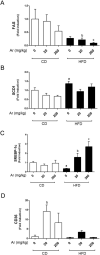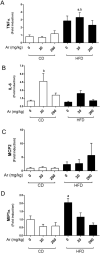Evaluation of Aroclor 1260 exposure in a mouse model of diet-induced obesity and non-alcoholic fatty liver disease
- PMID: 24998970
- PMCID: PMC4225625
- DOI: 10.1016/j.taap.2014.06.019
Evaluation of Aroclor 1260 exposure in a mouse model of diet-induced obesity and non-alcoholic fatty liver disease
Abstract
Polychlorinated biphenyls (PCBs) are persistent organic pollutants associated with non-alcoholic fatty liver disease (NAFLD) in epidemiologic studies. The purpose of this study was to evaluate the hepatic effects of a PCB mixture, Aroclor 1260, whose composition mimics human bioaccumulation patterns, in a mouse model of diet-induced obesity (DIO). Male C57Bl/6J mice were fed control diet or 42% high fat diet (HFD) and exposed to Aroclor 1260 (20mg/kg or 200mg/kg in corn oil) for 12weeks. A glucose tolerance test was performed; plasma/tissues were obtained at necropsy for measurements of adipocytokine levels, histology, and gene expression. Aroclor 1260 exposure was associated with decreased body fat in HFD-fed mice but had no effect on blood glucose/lipid levels. Paradoxically, Aroclor 1260+HFD co-exposed mice demonstrated increased hepatic inflammatory foci at both doses while the degree of steatosis did not change. Serum cytokines, ALT levels and hepatic expression of IL-6 and TNFα were increased only at 20mg/kg, suggesting an inhibition of pro-inflammatory cytokine production at the 200mg/kg exposure. Aroclor 1260 induced hepatic expression of cytochrome P450s including Cyp3a11 (Pregnane-Xenobiotic Receptor target) and Cyp2b10 (constitutive androstane receptor target) but Cyp2b10 inducibility was diminished with HFD-feeding. Cyp1a2 (aryl hydrocarbon Receptor target) was induced only at 200mg/kg. In summary, Aroclor 1260 worsened hepatic and systemic inflammation in DIO. The results indicated a bimodal response of PCB-diet interactions in the context of inflammation which could potentially be explained by xenobiotic receptor activation. Thus, PCB exposure may be a relevant "second hit" in the transformation of steatosis to steatohepatitis.
Keywords: AhR; Aroclor 1260; CAR; NAFLD; PCBs; PXR.
Copyright © 2014. Published by Elsevier Inc.
Figures







Similar articles
-
Polychlorinated biphenyl 153 is a diet-dependent obesogen that worsens nonalcoholic fatty liver disease in male C57BL6/J mice.J Nutr Biochem. 2013 Sep;24(9):1587-95. doi: 10.1016/j.jnutbio.2013.01.009. Epub 2013 Apr 22. J Nutr Biochem. 2013. PMID: 23618531 Free PMC article.
-
Polychlorinated Biphenyl-Xenobiotic Nuclear Receptor Interactions Regulate Energy Metabolism, Behavior, and Inflammation in Non-alcoholic-Steatohepatitis.Toxicol Sci. 2016 Feb;149(2):396-410. doi: 10.1093/toxsci/kfv250. Epub 2015 Nov 25. Toxicol Sci. 2016. PMID: 26612838 Free PMC article.
-
Drug metabolizing enzyme induction pathways in experimental non-alcoholic steatohepatitis.Arch Toxicol. 2008 Dec;82(12):959-64. doi: 10.1007/s00204-008-0312-z. Epub 2008 May 17. Arch Toxicol. 2008. PMID: 18488193 Free PMC article.
-
Polychlorinated biphenyls exposure and type 2 diabetes: Molecular mechanism that causes insulin resistance and islet damage.Environ Toxicol. 2024 Apr;39(4):2466-2476. doi: 10.1002/tox.24094. Epub 2024 Feb 2. Environ Toxicol. 2024. PMID: 38305644 Review.
-
Identification of Environmental Chemicals Associated with the Development of Toxicant-associated Fatty Liver Disease in Rodents.Toxicol Pathol. 2015 Jun;43(4):482-97. doi: 10.1177/0192623314549960. Epub 2014 Oct 16. Toxicol Pathol. 2015. PMID: 25326588 Free PMC article. Review.
Cited by
-
Dioxin-like and non-dioxin-like PCBs differentially regulate the hepatic proteome and modify diet-induced nonalcoholic fatty liver disease severity.Med Chem Res. 2020 Jul;29:1247-1263. doi: 10.1007/s00044-020-02581-w. Epub 2020 Jun 7. Med Chem Res. 2020. PMID: 32831531 Free PMC article.
-
Role of xenobiotics in the induction and progression of fatty liver disease.Toxicol Res (Camb). 2018 May 18;7(4):664-680. doi: 10.1039/c7tx00326a. eCollection 2018 Jul 1. Toxicol Res (Camb). 2018. PMID: 30090613 Free PMC article. Review.
-
Environmental perfluoroalkyl acid exposures are associated with liver disease characterized by apoptosis and altered serum adipocytokines.Environ Pollut. 2019 Apr;247:1055-1063. doi: 10.1016/j.envpol.2019.01.064. Epub 2019 Jan 18. Environ Pollut. 2019. PMID: 30823334 Free PMC article.
-
MCLR-elicited hepatic fibrosis and carcinogenic gene expression changes persist in rats with diet-induced nonalcoholic steatohepatitis through a 4-week recovery period.Toxicology. 2021 Dec;464:153021. doi: 10.1016/j.tox.2021.153021. Epub 2021 Nov 2. Toxicology. 2021. PMID: 34740672 Free PMC article.
-
PCB169 exposure aggravated the development of non-alcoholic fatty liver in high-fat diet-induced male C57BL/6 mice.Front Nutr. 2024 May 7;11:1350146. doi: 10.3389/fnut.2024.1350146. eCollection 2024. Front Nutr. 2024. PMID: 38779445 Free PMC article.
References
-
- Al-Salman F, Plant N. Non-coplanar polychlorinated biphenyls (PCBs) are direct agonists for the human pregnane-X receptor and constitutive androstane receptor, and activate target gene expression in a tissue-specific manner. Toxicol. Appl. Pharmacol. 2012;263:7–13. - PubMed
-
- Beyer A, Biziuk M. Environmental fate and global distribution of polychlorinated biphenyls. Rev. Environ. Contam. Toxicol. 2009;201:137–158. - PubMed
-
- Bligh EG, Dyer WJ. A rapid method of total lipid extraction and purification. Can. J. Biochem. Physiol. 1959;37:911–917. - PubMed
-
- Breivik K, Sweetman A, Pacyna JM, Jones KC. Towards a global historical emission inventory for selected PCB congeners—a mass balance approach. 1. Global production and consumption. Sci. Total Environ. 2002;290:181–198. - PubMed
Publication types
MeSH terms
Substances
Grants and funding
LinkOut - more resources
Full Text Sources
Other Literature Sources
Medical

